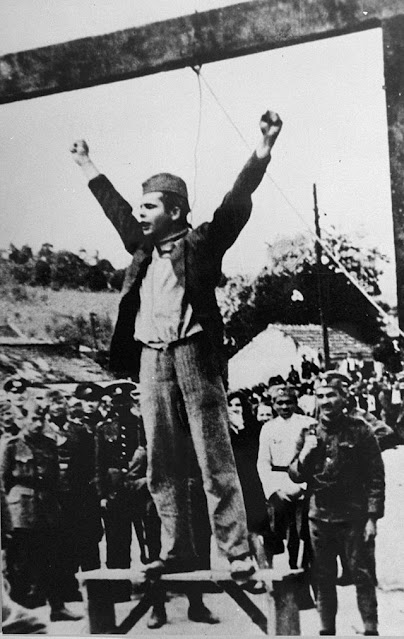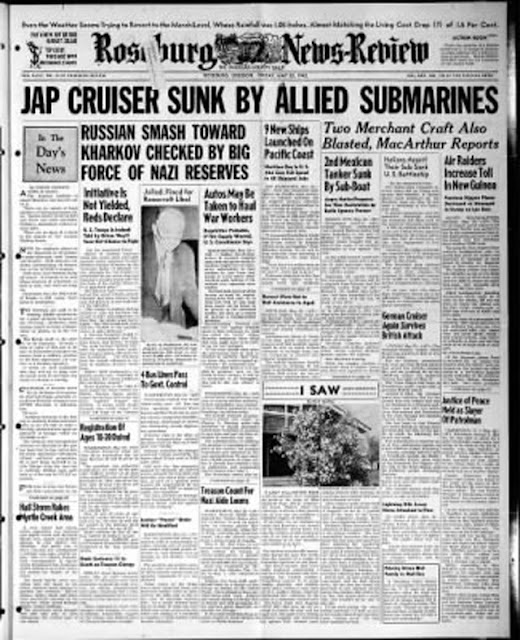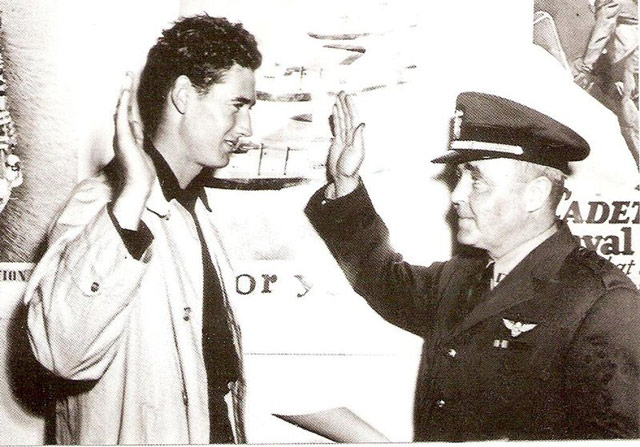Friday 22 May 1942
 |
| Stjepan Filipović shouting "Death to fascism, freedom to the People!" seconds before his execution on May 22 1942. Filipović was declared a National Hero of Yugoslavia on 14 December 1949. |
Battle of the Pacific: In one of the most significant intelligence coups of World War II, US Navy cryptanalysts on 22 May 1942 decode a Japanese message from 20 May confirming that Midway is their next invasion target. Because of what it leads to, the decryption is the turning point of the war in the Pacific.
For weeks, American naval intelligence has known that a place codenamed "AF" by the Japanese is the next objective. Falling for a classic ruse in which US forces on Midway sent messages pretending to have a water shortage, the Japanese unknowingly blundered into the trap and gave the entire game away. The analysts today decode a routine Japanese message from later the same day as the phony radio messages from Midway were sent (20 May) from a low-level Japanese bureaucrat stating that "AF is short of water" so the invasion fleet should bring additional water supplies. This confirms growing US suspicions about Japanese intentions and helps the US Navy plan a strategy to defend the isolated island and turn the tables on the overly aggressive Japanese.
That's not all. The cryptanalysts today also decode portions of a lengthy message sent by Japanese Admiral Yamamoto (subject line "Operational Order 14") also sent on 20 May. The message details the invasion plans in great detail. Based on these interceptions, Commander Joseph Rochefort and his team at Station HYPO (also known as Fleet Radio Unit Pacific, or FRUPAC) in Hawaii are able to provide Admiral Chester Nimitz with precise details about the projected date of the invasion (4 or 5 June 1942). This information includes the Imperial Japanese Navy order of battle. Based on previous intelligence, Nimitz already has ordered Admiral "Bull" Halsey to bring his aircraft carriers USS Enterprise and Yorktown back to Pearl Harbor from the Southwest Pacific to prepare for the battle. Now, everyone can plan a trap at Midway when otherwise the US Navy might not even have had any ships in the area.
Meanwhile, the Japanese continue their methodical preparations for the upcoming battle. Cruiser Division 8 and the battleships Kongo and Kirishima depart the Inland Sea of Japan today. Other ships under Admiral Nagumo already are at sea.
US submarine Silversides (SS-236) torpedoes and damages 4550-ton Japanese Navy freighter Asahisan Maru in the Kii Strait. The ship loses its bow but the captain manages to beach it to prevent sinking. The Japanese refloat Asahisan Maru on 27 May 1942 and return it to service on 15 July 1943.
US submarine Tautog (SS-199) torpedoes and damages Japanese freighter Sanko Maru southwest of the large Japanese base at Truk.
The USAAF continues its attacks on Japanese bases in New Guinea. B-17s of the 5th Air Force attacks Lakunai Airfield, while B-25 and B-26 bombers attack shipping and the airfield at Lae. Two B-25s fail to return.
 |
| Like many other US newspapers, the 22 May 1942 Roseburg (Oregon) News-Review celebrates US Navy submarine successes. |
Eastern Front: By now thoroughly aware of the peril facing his advanced units south of Kharkov in Army Group Kotenko, Soviet Marshal Timoshenko orders those troops to begin an orderly withdrawal to the east. He plans their departure for 23 May by the 9th and 57th Soviet armies through the narrow corridor to the east still held by Red Army troops.
The Wehrmacht forces attempting to cut Soviet Army Group Kotenko off, meanwhile, complete their encirclement late in the day. The 14th Panzer Division, advancing from Petrovskoye, lunges north and completes the final eight miles to make contact with Sixth Army units at Balakleya. At the same time, the 16th Panzer Division and 60th Motorized Divisions broaden the slender corridor the panzers have established between the massive Red Army forces to both east and west. They drive northwestward from Petrovskoye to meet other German troops ten miles west of Balakleya.
At Fuhrer Headquarters, General Franz Halder notes "The Izyum pocket has been weakly sealed on its eastern periphery." He notes disapprovingly that Field Marshal Fedor von Bock's plan to strengthen the encirclement:
is not well-conceived; it calls for an attack ... from the constricted bridgehead at Andreyyevka. To my mind, this is a very ineffectual solution. The right thing to do would be to have the armor now becoming available east of Kharkov strike for Savintai, on the north bank of the Donets. Bock had a talk with the Fuehrer and secured approval for his plan. I think it is wrong.
It is interesting that Halder, from his lofty position at the top of the military chain of command, feels so free to criticize decisions made by both a field marshal and Hitler in his official war diary. It probably helps that Hitler is in Berlin today (and for the next couple of days), giving Halder a sense of freedom from the oppressive twice-daily situation conferences. This incident also shows that Hitler was not always wrong and the generals right about military strategy, as the approved strategy turns out to be far from "ineffectual" and in fact leads to one of the greatest German victories of World War II.
Far to the north, German troops remain committed to the siege of Leningrad. Artillery fire sinks two Soviet Navy torpedo boats, TKA-103 and TKA-123. With the ice melting in the spring thaw, the Germans fear a Soviet naval breakout into the Baltic.
European Air Operations: Continuing a major lull in operations that lasts throughout May 1942, neither side launches any major attacks. The only significant activity is a mission by 27 Halifax bombers to attack the U-boat pens at St. Nazaire. Poor weather prevents all but three bombers from dropping their bombs. An additional 31 bombers lay mines off St. Nazaire and the German Baltic ports. No aircraft are lost.
 |
| Canadian freighter Frank B. Baird, sunk by U-158 on 22 May 1942. |
Battle of the Atlantic: U-753 (KrvKpt. Alfred Manhardt von Mannstein), on its fourth patrol out of La Pallice, surfaces and stops 326-ton British three-masted schooner E.P. Theriault in the Gulf of Mexico 55 miles west of Dry Tortuga. The Germans allow an orderly evacuation of the ship and then attempt to scuttle it, but they fail and it drifts ashore in the Bay of Cardenes, Cuba, on 27 May. The ship is refloated, repaired, and sold to Cuba, where it sails as the Ofelia Gancedo. The crew survives and makes landfall in Cuba in their lifeboats.
U-158 (Kptlt. Erwin Rostin), on its second patrol out of Lorient, surfaces and sinks 1748-ton Canadian freighter Frank B. Baird far south of Bermuda. Rostin uses his deck gun to sink the freighter. Norwegian freighter Talisman rescues the 23 crewmen and takes them to Point Noire, French Equatorial Africa.
U-588 (Kptlt. Victor Vogel), on its third patrol out of St. Nazaire, torpedoes and sinks 3282-ton US freighter Plow City 200 nautical miles (370 km) east of Cape May, New Jersey. There are one death and 30 survivors, who are picked up by USS Sapphire.
Battle of the Mediterranean: It is a quiet day at Malta, perhaps the first such day in months. There are a couple of Luftwaffe patrols near the island, but no bombing attacks and no fighter interceptions. RAF forces have been built up to previously unheard of strength recently.
Partisans: Serbian security forces hang partisan Stjepan Filipović, 26, at Valjevo, Yugoslavia (Serbia). Filipović, a communist and ethnic Croat, was commander of the Partisans' Tamnavsko-Kolubarski unit in Valjevo. A photo of him (top of this page) becomes famous worldwide as a symbol of resistance to tyrrany. There is a statue to Filipović in Valjevo. Both of his brothers also perish in the partisan operations.
 |
| As the 22 May 1942 El Paso Herald-Post headlines, Mexico takes a dim view of U-boat sinkings of Mexican ships. |
Mexican/Axis Relations: As a consequence of U-boat sinkings of Mexican ships, including one on 20 May 1942 by U-106, Mexico declares war on Germany, Italy, and Japan.
US Military: The 19th Fighter Squadron, 18th Fighter Group, 7th Air Force transfers its P-40s from Bellows Field in Waimanalo to the new nearby Kualoa Field at Kualoa Ranch, Hawaii, while the 73rd Fighter Squadron transfers from Wheeler Field to Bellows Field to replace it. Kualoa is a satellite field used for training. Among its typical characteristics are that it is made of perforated high strength steel (Marston mats) and that the runway crosses a road (Kamehameha Highway) to the north shore.
Under General Orders 25, the US 1st Armored Division in Northern Ireland is divided into three units for training, discipline, and administration.
Former Ambassador to France Admiral William D. Leahy boards Swedish liner Drottningholm at Lisbon, Portugal, for his voyage home to New York.
German Military: General Halder records that he has a meeting with Count Claus von Stauffenberg and Lt. Colonel Mueller-Hillebrand about staffing and "other current organization matters."
Halder also notes in his diary, "Preparation for chemical warfare." This is in reference to a meeting with Genera Wilhelm-Francis Ochsner. This is one of several oblique references in Halder's diary to the possible use of poison gas. There are allegations that the Wehrmacht used gas against Soviet partisans using catacombs south of Kerch, Crimea, around this time. To be fair, both sides make contingency preparations (including the production of large quantities of poison gas) for the possible use of chemical weapons throughout the war.
 |
| Adolf Hitler and Hermann Goering attend the funeral of Gauleiter Carl Röver in Berlin on 22 May 1942. It appears the widow is sitting next to Hitler in the place of honor. Also visible in the second row are Joseph Goebbels and Heinrich Himmler (mostly obscured). |
German Government: In Berlin for a couple of days, Adolf Hitler attends the funeral of Gauleiter Carl Röver (Reichsstatthalter for the states of both Oldenburg and Bremen) in the mosaics room at the Chancellery. Röver, 53, officially died of either pneumonia or heart failure.
Why Obergruppenführer Röver, a relatively minor party functionary but longtime NSDAP member since 1924, merits Hitler's attention and lavish ceremony at the Chancellery is a bit unclear. Some historians, including David Irving, have claimed that Röver was assassinated on orders from Martin Bormann - ostensibly Röver's friend and sponsor - because Röver was proving to be an embarrassment to the NSDAP due to progressive dementia caused by advanced syphilis.
But there may be more to it. For years, Röver successfully has resisted Hermann Goering's (who also attends the funeral) attempts to incorporate Bremen into Prussia (Goering is Minister of the Interior for Prussia). Hitler consistently took Röver's side, and Goering could not have been too happy about that. This ceremony may be an oblique way for Hitler to signal that he still agrees with the deceased Röver and opposes Goering's empire-building plans.
 |
| Reich Minister Alfred Rosenberg speaks during the Carl Röver funeral ceremony at the Chancellery, Berlin, on 22 May 1942. |
Australian Homefront: In Townsville, Australia, about 600 African-American servicemen (laborers) of the 96th Battalion, US Army Corps of Engineers, mutiny. They do so after hearing a rumor that a white office had struck or murdered a black sergeant. The mutineers already had been banned from Townsville due to previous incidents. The mutineers fire machine guns at the tents of white officers, with at least one death and dozens injured (a contemporary report says that 19 men are killed). The mutiny lasts for eight hours. A Texas congressman visiting Australia, Lyndon B. Johnson, arranges to suppress news of the mutiny, which does not become public until 2012. The mutiny is put down with the assistance of Australian infantry units armed with live ammunition. This is considered one of the worst mutinies in United States military history and it is the first of several similar incidents during World War II (Port of Chicago in July 1944, Agana, Guam, in December 1944, Freeman Air Force Field in Indiana in 1945).
 |
| Adolf Hitler (center) attends the funeral of Gauleiter Carl Röver on 22 May 1942. |
Holocaust: Transport trains arrive at Auschwitz carrying 1000 Slovak Jewish citizens transferred from Majadanek Concentration Camp at Lublin. Another nine previously arrested by the state security services (Sipo and SD) arrive from Helcl Prison in Krakow. Almost all of the new arrivals are dead by mid-August.
American Homefront: Baseball star Ted Williams enlists in the Navy Reserve after initially petitioning to be exempt from the draft as the sole source of support for his mother (Class 3-A). Pushback from sponsors and fans have contributed to his change of heart.
The Navy allows Williams to finish out the season. Williams will become a second lieutenant in the United States Marine Corps as a Naval Aviator. Having batted .406 in 1941 (the last player to best .400 to date), Williams is having another outstanding year and is on his way to the American League Triple Crown (leading in batting average, runs batted in, and home runs). After being called to duty in November 1942, Williams will miss the 1943, 1944, and 1945 baseball seasons.
The United Steel Workers of America is formed as a combination of smaller unions.
 |
| A poster celebrating the entry of Mexico in the war on 22 May 1942. |
Future History: Theodore John Kaczynski is born in Chicago, Illinois. In high school, he shows a strong interest in mathematics and develops a reputation as a "walking brain." After participating in mind control experiments that may be part of the CIA's Project MKUlttra, he graduates from Harvard in 1962. He becomes a doctor of mathematics in 1967 but resigns from a teaching position abruptly in 1969. In the 1970s, he moves to a remote cabin in Lincoln, Montana, attempting to become self-sufficient. He develops obsessive views against development and begins acting violently, including setting booby traps and committing arson. This develops into his mailing or hand-delivering bombs to individuals he associates with trees and forests, including at least two individuals who apparently are targeted simply because their last names are "Wood."
For these violent acts, the as-yet-unidentified Kacynski becomes commonly known as the "Unabomber." This continues intermittently until 1995, when the Washington Post accedes to his demands and publishes his crazed manifesto condemning the Industrial Revolution. After a massive investigation, the FBI arrests Kaczynski on 3 April 1996. As of mid-2021, Ted Kaczynski is serving eight life sentences without the possibility of parole at a supermax prison in Florence, Colorado.
Barbara Parkins is born in Vancouver, British Columbia, Canada. At the age of 16, she moves with her mother to Los Angeles, California, where she studies acting. She makes her film debut in "20,000 Eyes" (1961). Later in the decade, she stars in ABC primetime soap opera "Peyton Place" and the film adaptation of Jacqueline Susann's novel "Valley of the Dolls." This begins an extensive acting career that lasts through the 1990s. As of mid-2021, Barbara Parkins is a photographer.
Richard Raul "Richie" Garcia is born in Key West, Florida. After serving in the US Marine Corps as a combat engineer in the early 1960s, Garcia becomes a baseball umpire in 1970. He goes on to a prominent and popular career as a leading American League umpire that has several high-profile controversies, including his participation in the 1999 Major League Umpires Association mass resignation (which ends his umpiring career, though he returns to baseball in other capacities). As of mid-2021, Richie Garcia is retired in Florida.
Barbara Parkins is born in Vancouver, British Columbia, Canada. At the age of 16, she moves with her mother to Los Angeles, California, where she studies acting. She makes her film debut in "20,000 Eyes" (1961). Later in the decade, she stars in ABC primetime soap opera "Peyton Place" and the film adaptation of Jacqueline Susann's novel "Valley of the Dolls." This begins an extensive acting career that lasts through the 1990s. As of mid-2021, Barbara Parkins is a photographer.
Richard Raul "Richie" Garcia is born in Key West, Florida. After serving in the US Marine Corps as a combat engineer in the early 1960s, Garcia becomes a baseball umpire in 1970. He goes on to a prominent and popular career as a leading American League umpire that has several high-profile controversies, including his participation in the 1999 Major League Umpires Association mass resignation (which ends his umpiring career, though he returns to baseball in other capacities). As of mid-2021, Richie Garcia is retired in Florida.
 |
| College co-eds pitch in to help with the war effort. Skyscraper, 22 May 1942, Mundelein College Records, Loyola University Chicago Digital Special Collections, accessed June 3, 2021. |

No comments:
Post a Comment